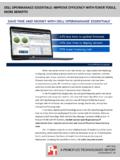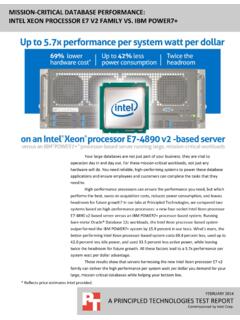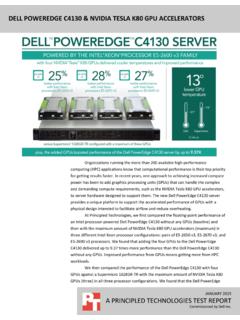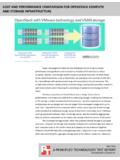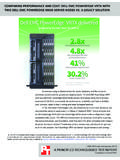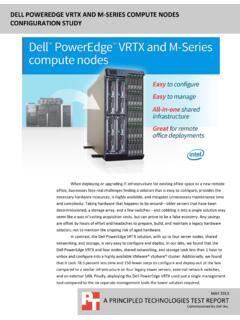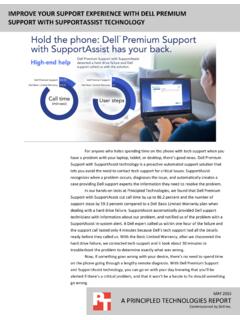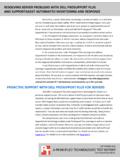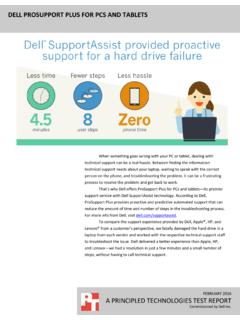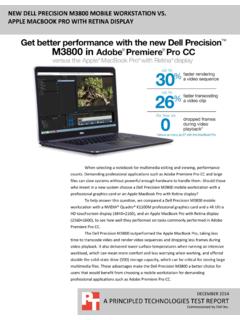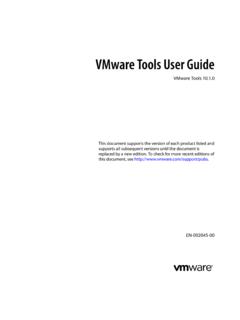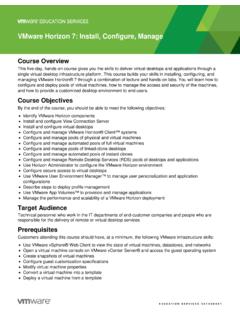Transcription of DELL 3-2-1 REFERENCE CONFIGURATIONS: HIGH …
1 DELL 3-2- 1 reference configurations : high - availability VIRTUALIZATION WITH DELL POWEREDGE R720 SERVERS A Principled Technologies configuration guide commissioned by Dell Inc. TABLE OF CONTENTS Table of contents .. 2 Introduction .. 4 Why 3-2-1 ?..4 Features of the new Dell PowerEdge R720 ..5 About the Intel Xeon processor E5 family ..6 About VMware vSphere 5 ..6 About Dell Management Plug-In for VMware vCenter ..6 About Microsoft SQL Server 2008 R2 ..7 About Microsoft Exchange Server 2010 SP2 ..7 About Microsoft SharePoint Server 2010 ..7 We show you how Setting up your Dell 3-2-1 REFERENCE configuration .. 7 Cabling ..8 Configuring the management server .. 10 Setting up the switches .. 10 Setting up the storage .. 11 Configuring the ESXi host servers .. 12 Creating and configuring a cluster in vCenter Server .. 13 Configuring the storage .. 13 Configuring the networking .. 13 Configuring the Dell Management vCenter plug-in .. 14 Creating the virtual machines.
2 15 Configuring the virtual machines .. 16 Summing it all up .. 24 Appendix A - Configuring the management server .. 25 Setting up vCenter Server .. 25 Appendix B - Setting up the switches and storage .. 26 Creating a VLAN and assigning ports on the Dell PowerConnect 6224 switch .. 26 Saving the Dell PowerConnect 6224 switch configuration .. 26 Setting up the Dell EqualLogic PS6100XV storage .. 26 Appendix C - Configuring the ESXi host servers .. 28 Configuring vSphere 5 (ESXi) after installation .. 28 Installing the Dell EqualLogic Multipathing Extension Module (MEM) version Beta on the ESXi servers .. 28 Appendix D - Creating and configuring a cluster .. 29 Installing vSphere Client .. 29 Creating a cluster using the vSphere Client .. 29 Appendix E - Configuring the storage .. 30 Configuring the Dell EqualLogic PS6100XV for access from the host servers .. 30 Configuring the external volumes in VMware vSphere 5 .. 30 Appendix F - Configuring networking .. 31 Configuring VM networking on ESXi.
3 31 Configuring the vMotion network .. 31 Configuring iSCSI networking on ESXi .. 31 Appendix G - Configuring the Dell Management vCenter Plug-in .. 33 Appendix H - Creating the virtual machines .. 34 Creating the VMs .. 34 Installing the operating system on the VMs .. 34 Adding the external volumes to the VMs in VMware vSphere 5 .. 35 Appendix I - Configuring the virtual machines .. 36 Installing SQL Server 2008 R2 on VM #1 .. 36 Installing Exchange Server 2010 SP2 on VM #2 .. 37 Installing SharePoint Server 2010 on VM #3 .. 39 About Principled Technologies .. 40 A Principled Technologies configuration guide 4 Dell 3-2- 1 reference configurations : high - availability virtualization with Dell PowerEdge R720 servers INTRODUCTION Choosing the right combination of hardware and software for your data center can be a daunting task. You need powerful servers to run your applications in virtual machines, reliable storage to safely store your data, and software to help you manage your infrastructure.
4 Because your applications must run with little to no downtime, your infrastructure requires several components, some redundant, to maintain high availability : at least two virtual machine host servers, a management server, storage, and switches to put the pieces together. Is there a simple and foolproof way to ensure you get the best hardware and software that all works together for your data center? Dell 3-2- 1 reference configurations take the guesswork out of designing, ordering, and deploying your virtualized infrastructure in your data center. Dell has designed proven, tested architecture to help you deploy a solution that meets your needs. In this guide, we discuss the different pieces that comprise a Dell 3-2-1 REFERENCE configuration , the benefits they bring to your organization, and how to deploy your new solution using best practice recommendations and guidelines from Dell. For the results of our performance tests for this solution, see our companion performance report, where we found that the solution could support 1,000 users with room for future growth, at Why 3-2-1 ?
5 Dell 3-2- 1 reference configurations consist of three servers, two switches, and one storage array. This type of configuration allows you to keep your infrastructure up and running, even in the face of hardware failure, so you have very little downtime and can keep your business running smoothly. In this guide, we focus on a 3-2-1 REFERENCE configuration built on the latest Dell PowerEdge R720 servers, powered by new Intel Xeon processors E5-2680. Two of these servers can host your VMware vSphere 5 virtual machines (VMs) and run all of your critical business applications, while giving you failover protection. Our example servers hosted VMs running three common business-critical applications from Microsoft : SQL Server 2008 R2, Exchange Server 2010 SP2, and SharePoint Server 2010. To learn more about the Dell PowerEdge R720 and the benefits it brings to your business, please see the Features of the new Dell PowerEdge R720 section below. The third server in this configuration , a Dell PowerEdge R620, ran as a management server.
6 A Principled Technologies configuration guide 5 Dell 3-2- 1 reference configurations : high - availability virtualization with Dell PowerEdge R720 servers Two Dell PowerConnect 6224 switches allow stacking to provide interconnectivity and ample bandwidth for any network traffic, isolate different types of network traffic via VLANs, and maintain high availability in the event of a switch failure. The Dell EqualLogic PS6100XV storage array rounds out the 3-2-1 REFERENCE configuration , with excellent I/O performance, optimized scalability, and flexible management options to meet all your storage and performance needs. Features of the new Dell PowerEdge R720 Figure 1: The new Dell PowerEdge R720 server, powered by the Intel Xeon processor E5-2680. The new Intel Xeon processor E5-2680-powered Dell PowerEdge R720 2U rack server incorporates many improvements and features designed to improve performance, lower power consumption, and make maintenance easier. Some of these features include the following: Performance.
7 Dell engineered the PowerEdge R720 to handle complex workloads, with I/O and internal data management technologies ( , NSC, NPAR, CacheCade) to allow faster access to information and GPU accelerators to solve challenges faster than ever. Processors. The Dell PowerEdge R720 is powered by two Intel Xeon processors E5-2680, which incorporate the very latest in processor technology from Intel. The powerful processors provide exceptional performance and make the PowerEdge R720 a powerful virtualization platform. Power efficiency. Dell PowerEdge R720 servers implement leading industry power efficiency standards, and are designed to optimize performance while maintaining low power consumption. Automated tracking and regulation of thermal activity, intelligent design of right-sized power options, and high efficiency fans and airflow management work to save power, saving you money in the process. Management. The Dell PowerEdge R720, like all late-model Dell servers, comes with the Dell Lifecycle Controller.
8 This tool simplifies server management by providing a single A Principled Technologies configuration guide 6 Dell 3-2- 1 reference configurations : high - availability virtualization with Dell PowerEdge R720 servers interface for management functions and by storing critical system information in the system itself. There are no CDs or USB keys to keep track of for drivers or firmware. Storage. With impressive storage capacity for small business servers, the Dell PowerEdge R720 is available in both an 8-bay and 16-bay chassis. Memory. The Dell PowerEdge R720 holds up to 768 GB of RAM, many times the RAM capacity of older small business servers, allowing for powerful flexibility with virtualized database solutions. About the Intel Xeon processor E5 family The new Intel Xeon processor E5 family, which comes standard in new Dell PowerEdge servers, incorporates new technology and features to meet the computing demands of the present and future. The Intel Xeon processor E5 family delivers intelligent and adaptive performance using such features as Intel Turbo Boost Technology , Intel Advanced Vector Extension, Intel Integrated I/O, and Intel Data Direct I/O Technology.
9 These new processors also feature Intel Trusted Execution Technology (Intel TXT) and utilize Intel Advance Encryption Standard New Instructions (Intel AES-NI) to help keep your data safe. For more information about the Intel Xeon processor E5 family, including the Intel Xeon processor E5-2680, visit About VMware vSphere 5 vSphere 5 is the latest virtualization operating system from VMware. vSphere 5 virtualizes server, storage, and networking resources, achieving a consolidation ratio greater than 15:1. Features such as automated management and dynamic resource allocation improve efficiency. The services that vSphere 5 provides fall into two categories: Infrastructure services or application services. The former handle the virtualization of resources and their allocation to application when most needed, while the latter provide service-level controls to applications running on vSphere 5. To learn more about VMware vSphere 5, visit About the Dell Management Plug-In for VMware vCenter The Dell Management Plug-In for VMware vCenter simplifies many tasks IT administrators need to perform on a routine basis, such as discovering, monitoring, managing, patching, and deploying ESXi to Dell servers without the need of an agent running on the servers.
10 Using Dell Management Plug-In for VMware vCenter, A Principled Technologies configuration guide 7 Dell 3-2- 1 reference configurations : high - availability virtualization with Dell PowerEdge R720 servers administrators can also monitor networking and storage. The Dell Management Plug-In for VMware vCenter allows administrators to easily view the status of multiple ESXi servers and fully manage them from within the vCenter console. The plug-in, developed as part of the Dell OpenManage collection of software, is easily deployed into an existing vCenter Server. About Microsoft SQL Server 2008 R2 SQL Server 2008 R2 is the latest release of Microsoft s database management platform. As with each release, Microsoft has added new features to expand on the capabilities of their Database Management System (DBMS) platform. Where earlier versions of SQL Server required database administrators to rely primarily on either in-house applications or third-party tools to monitor multiple instances, SQL Server 2008 R2 simplifies multi-server management.
